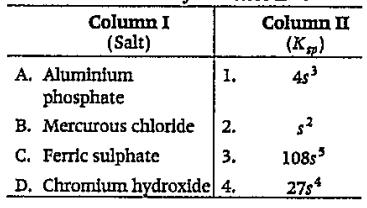Match the organism with its related contribution in the field of biotechnology.
Column-IColumn-II1Escherichia coliI1strDNA2Agrobacterium tumefaciensIIpBR3223Thermus aquaticusIIITi plasmid4Salmonella typhimuriumIVPolymerase used in PCR
1 - I , 2 - III , 3 - II , 4 - IV
1 - II, 2 - III , 3 - IV , 4 - I
1 - III , 2 - IV , 3-IV , 4 - I
1 - II , 2 - I , 3 - IV , 4 - III
The correct Answer is:B
To solve the question of matching organisms with their contributions in the field of biotechnology, we will analyze each organism and its associated contribution step by step.
Step 1: Identify the contributions of each organism
1. Escherichia coli (E. coli): This bacterium is widely used in molecular cloning and is known for its role in recombinant DNA technology. The plasmid pBR322 was one of the first vectors used for cloning in E. coli.
2. Agrobacterium tumefaciens: This bacterium is known for its ability to transfer DNA to plants, specifically through the Ti plasmid (tumor-inducing plasmid). It is used in plant genetic engineering.
3. Thermus aquaticus: This thermophilic bacterium is known for its heat-stable DNA polymerase, which is used in the Polymerase Chain Reaction (PCR). The enzyme is crucial for amplifying DNA.
4. Salmonella typhimurium: This bacterium has been used in various genetic studies and was instrumental in the development of recombinant DNA technology.
Step 2: Match the organisms with their contributions
Now we will match each organism with its respective contribution based on the information gathered:
- Escherichia coli: Matches with pBR322 (II)
- Agrobacterium tumefaciens: Matches with Ti plasmid (III)
- Thermus aquaticus: Matches with Polymerase used in PCR (IV)
- Salmonella typhimurium: Matches with 1st rDNA (I)
Step 3: Present the final matches
Now we can summarize the matches:
1. Escherichia coli → pBR322 (II)
2. Agrobacterium tumefaciens → Ti plasmid (III)
3. Thermus aquaticus → Polymerase used in PCR (IV)
4. Salmonella typhimurium → 1st rDNA (I)
Final Answer:
The correct matches are:
1. E. coli → II (pBR322)
2. Agrobacterium tumefaciens → III (Ti plasmid)
3. Thermus aquaticus → IV (Polymerase used in PCR)
4. Salmonella typhimurium → I (1st rDNA)
1. Escherichia coli (E. coli): This bacterium is widely used in molecular cloning and is known for its role in recombinant DNA technology. The plasmid pBR322 was one of the first vectors used for cloning in E. coli.
2. Agrobacterium tumefaciens: This bacterium is known for its ability to transfer DNA to plants, specifically through the Ti plasmid (tumor-inducing plasmid). It is used in plant genetic engineering.
Now we will match each organism with its respective contribution based on the information gathered:
- Agrobacterium tumefaciens: Matches with Ti plasmid (III)
- Thermus aquaticus: Matches with Polymerase used in PCR (IV)
- Salmonella typhimurium: Matches with 1st rDNA (I)
Now we can summarize the matches:
1. Escherichia coli → pBR322 (II)
2. Agrobacterium tumefaciens → Ti plasmid (III)
3. Thermus aquaticus → Polymerase used in PCR (IV)
4. Salmonella typhimurium → 1st rDNA (I)
The correct matches are:
1. E. coli → II (pBR322)
2. Agrobacterium tumefaciens → III (Ti plasmid)
3. Thermus aquaticus → IV (Polymerase used in PCR)
4. Salmonella typhimurium → I (1st rDNA)
Topper's Solved these Questions
Similar Questions
Match the salt in Column I with its relation for Ksp in Column II in terms of solubility s in mol L−1.

View SolutionMatch the shape of molecules in Column 1 with the type of hybridisation in Column II.
Column IColumn II(a)Tetrahedral(i)sp2(b)Trigonal(ii)sp(c)Linear(iii)sp3(d)Trigonal bipyramidal(iv)sp3d
View Solution
Knowledge Check
Match the pairs of diseases and pathogens:
Column-IColumn-II1. Malariaa. Wuchereria bancrofti2. Filariasisb. Helminth3. Typhoidc. Plasmodium falciparum4. Schistosomiasisd. Salmonella typhiA1-c, 2-b, 3-a, 4-dB1-d, 2-a, 3-b, 4-cC1-a, 2-b, 3-c, 4-dD1-c, 2-a, 3-d, 4-bMatch the column and select the correct option.
Column - IColumn - II(1)Leaf tendril(i)Cactus(2)Leaf Spine(ii)Pea(3)Stem tendril(iii)Bougainvillea(4)Stem thorn(iv)Gourds(v)TurmericA1 - v, 2- iii, 3 - ii, 4 - iB1 - ii, 2- iii, 3 - iv, 4 - iC1 - iv, 2- i, 3 - v, 4 - iiiD1 - ii, 2- i, 3 - iv, 4 - iiiMatch the column - I with column - II
Column - IColumn - II1.MicronutrientsA.Fe2.Macronutrients B.Nitrosomonas3.NitrificationC.S4.DenitrificationD.ThiobacillusA1 - C , 2 - A , 3 - D , 4 - BB1 - C , 2 - A , B , 4 - DC1 - A , 2 - C , 3 - D , 4 - BD1 - A , 2 - C , 3 - B , 4 - D
Match the following columns and select the correct option.
Column-IColumn-II1.Floating ribsiLocated between second and seventh ribs2.AcromioniiHead of the humerus3.ScapulaiiiClavicle4.Glenoid cavityivDo not connect with sternum
View SolutionMatch the organism in Column I with the contents in Column II.
Column IColumn IIA.Gracilaria1.BiflagellateB.Ectocarpus2.ElatersC.Marchantia3.Biflagellate antherozoidsD.Cycas4.Carpogonium5.Multiciliated male gametes
View SolutionMatch the items in Column I with those in Column II :
Column IColumn - II1.Herbivores-Plants(i)Commensalism2.Mycorrhiza-Plants(ii)Mutualism3.Sheep-Cattle(iii)Predation4.Orchid-Tree(iv)Competition
View SolutionMatch the following columns
Column IColumn IIa. Cisacontic acidI. 2-carbonb. Fumaric acidII. 3-carbonc. 2-PGAIII. 4-carbond. Acetyl CoAIV. 6-carbon
View SolutionMatch the causative organisms with their diseases:
Column-IColumn-IIA Haemophilus influenzae1. Malignant malariaB Entamoeba histolytica2. ElephantiasisC Plasmodium falciparum3. PneumoniaD Wuchereria bancrofti4. TyphoidE Salmonella typhi5. Amoebiasis
View Solution
